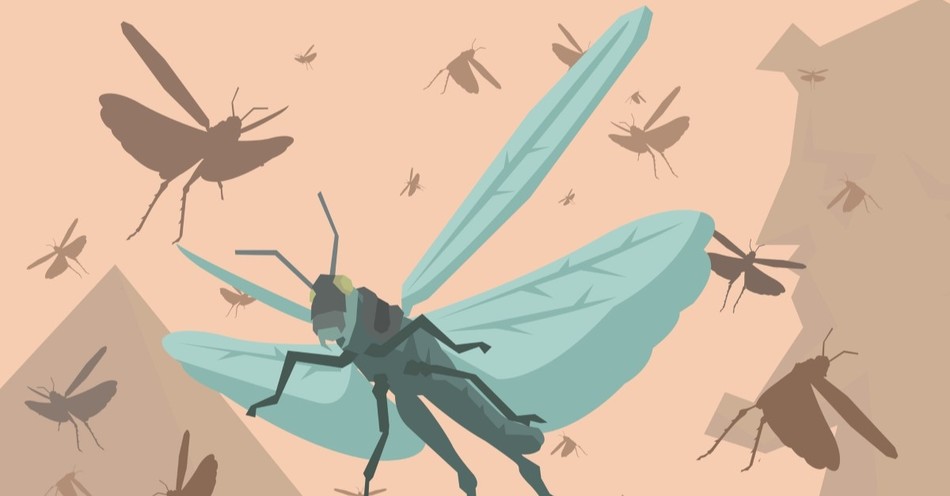The Book of Revelation, the final chapter of the New Testament, is a captivating text filled with apocalyptic visions and rich symbolism even including locusts.
In Revelation 9, the imagery of the locusts is both vivid and symbolic. We see these locusts appear after the fifth trumpet. In this passage, the fifth angel sounds his trumpet, and a star falls from the sky to the earth. This star is given the key to the bottomless pit. When the pit is opened, smoke rises and darkens the sky. From the smoke, locusts emerge with the power to torment people who do not have the seal of God on their foreheads for five months.
These locusts are described as having shapes like horses prepared for battle, with crowns of gold, human-like faces, hair like women's hair, lion's teeth, iron breastplates, and wings that sound like chariots. They also have tails with stingers like scorpions. Their leader is the angel of the bottomless pit, named Abaddon in Hebrew and Apollyon in Greek, meaning "Destroyer."
Unlike ordinary locusts that harm vegetation, these locusts are commanded not to damage the earth but to torment people who do not bear the seal of God on their foreheads for five months.
Symbolism of the Locusts - Wrath and Judgement
Prior to the final call, Revelation 9 portrays the appearance of locusts woven into the events of the fifth and sixth trumpets, designated as “woes” upon the world. In the biblical era, locusts were often seen as harbingers of God’s destruction and divine punishment.
They could devastate entire crops and lead to famine and suffering. In Exodus 10:4-6, when Pharaoh refused to permit the Hebrews to leave Egypt’s slavery, locusts became the instrument of the eighth plague upon Egypt.
Moses said, “If you refuse to let my people go, behold, tomorrow I will bring locusts into your country. And they shall cover the face of the land so that no one can see the land. And they shall eat what is left to you after the hail, and they shall eat every tree of yours that grows in the field."
God’s judgment and destruction with locusts in Joel’s prophecy against Judah says, "What the cutting locust left, the swarming locust has eaten. What the swarming locust left, the hopping locust has eaten, and what the hopping locust left, the destroying locust has eaten” (Joel 1:2-4).
Locusts, though not literal as they refrain from eating grass or vegetation, figuratively emerge in Revelation 9:1-12 as tormentors of nonbelievers. Verses 7-10 describe the locusts as otherworldly.
The Church's rapture in Revelation initiates God’s wrath being poured upon the world as His ultimate effort to guide Israel and the nations toward repentance.
Locusts, one of several apocalyptic and symbolic themes woven throughout Revelation, are God’s wrath unbridled against evil. In the final three and a half years of the Tribulation, the entire world will bear the weight of many woes and afflictions prior to Christ’s Second Coming.
Revelation 9:20-21 reveals the persistent lack of repentance despite locusts, woes, and plagues.
“The rest of mankind...did not repent of the works of their hands; they did not stop worshiping demons, and idols of gold, silver, bronze, stone and wood — idols that cannot see or hear or walk. Nor did they repent of their murders, their magic arts, their sexual immorality, or their thefts.”
The Leader of the Locusts
"And they had a king over them, which is the angel of the bottomless pit, whose name in the Hebrew tongue is Abaddon, but in the Greek tongue hath his name Apollyon."
In Revelation 9:11, the leader of the locusts is introduced. He is called Abaddon in Hebrew and Apollyon in Greek. Both names mean "Destroyer." This angel comes from the bottomless pit, a place of immense darkness and evil.
Abaddon/Apollyon leads the locusts in their mission to torment those who do not have God's seal on their foreheads. This emphasizes the organized and purposeful nature of the torment and highlights the severity of the divine judgment being described.
Biblical Context of the Apocalypse in Revelation
To better understand the symbolism of locusts and exploring the theological context in which the locusts appear, it is vital to understand the broader context of this apocalyptic text. The term “apocalypse” in Greek denotes the unveiling, uncovering, and revealing of something previously unknown.
Revelation was written by aged Evangelist John, who was exiled to the Isle of Patmos by the Roman government for preaching the gospel.
He received messages from Jesus directed to the seven churches, along with visions of the end times. “The revelation from Jesus Christ…the word of God and the testimony of Jesus” (Revelation 1:1, 2).
Through his prophetic vision of future events, like we read here with locusts, he disclosed God’s ultimate triumph over evil.
From chapters six to nineteen, Revelation details the impending seven-year tribulation period, a manifestation of God's judgment on wickedness. During this time, seven trumpets announce new judgements.
The church, removed through the rapture after Chapter Three, now dwells with the Lord in heaven. On earth, divine wrath is unleashed alongside the proclamation of “the gospel…to every nation, tribe, language, and people” (Revelation 14:6).
An angel flying urging all nations to “Fear God, give Him glory, and worship Him as the hour of His judgment arrives” (14:7). Those who reject the call will face the consequences of doom and eternal separation from a loving God.
Old Testament References for Locusts
Exodus 10:4-6: This passage describes the eighth plague in Egypt, where Moses warns Pharaoh that if he does not let the Israelites go, God will send a swarm of locusts that will cover the land and devour what the hail has left, including every tree growing in the fields.
Joel 1:4: The prophet Joel describes a devastating locust invasion with the words, "What the locust swarm has left, the great locusts have eaten; what the great locusts have left, the young locusts have eaten; what the young locusts have left, other locusts have eaten." This imagery serves as a metaphor for the consequences of turning away from God and a call to repentance.
Amos 7:1-2: Amos describes a vision where God is preparing a swarm of locusts just as the late crops were coming up. Amos intercedes for the people, asking God to forgive them.
Deuteronomy 28:38: This verse is part of the blessings and curses section, warning that if the Israelites disobey God, they will sow much seed in the field but harvest little because locusts will devour their crops.
Nahum 3:15: In this passage, Nahum uses the imagery of locusts to convey the relentlessness of divine judgment against oppressive powers, stating, “There the fire will devour you, the sword will cut you off; it will eat you up like a locust.”
These references illustrate how locusts are commonly used in the Old Testament as symbols of divine judgment and devastation, just like they are in Revelation.
Being Ready for Revelation
The appearance of locusts in last book of the Bible, is a stark reminder of God's justice coming upon the world, revealing the time of His wrath on wickedness. It also calls us to examine our hearts and see if we are ready for His return.
Revelation offers not just a vision of God’s punishment for sin and evil but also a message of hope, redemption, and the ultimate triumph of good over evil.
In Luke 18:8, Jesus asked, “When I come, will I find faith?” Amid the many demands on our time, what takes priority in guiding us toward eternity?
Jude urges us to "contend for the faith" (v. 3), emphasizing the ongoing spiritual battle that demands our constant devotion and persevering commitment to an authentic relationship with God.
Jesus said the one who “has my commands and keeps them is the one who loves me” (John 14:21). Without daily dressing in the spiritual battle armor of God’s Word, we become comfortably deceived by the culture and susceptible to worldly influences.
God’s Word will keep us from sin and guard against such enticements. Exploring the locusts in Revelation invites us to engage this powerful biblical narrative and analyze our priorities for eternal life. Are we ready for His coming? 2 Thessalonians 1:8-10 reminds us,
“He will punish those who do not know God and do not obey the gospel of our Lord Jesus. They will be punished with everlasting destruction and shut out from the presence of the Lord and from the glory of his might on the day he comes to be glorified in his holy people and to be marveled at among all those who have believed.”
For further reading:
What Is the Significance of the Plague of Locusts?
What Is the Timeline of Revelation?
Photo Credit: ©Getty Images/switchkun

This article is part of our larger End Times Resource Library. Learn more about the rapture, the anti-christ, bible prophecy and the tribulation with articles that explain Biblical truths. You do not need to fear or worry about the future!
The Second Coming of Jesus
Who Are the 144,000 in Revelation?
Who Are Gog and Magog in the Bible?
What Is the Apollyon?
Is the Apocalypse Mentioned in the Bible?
Signs of the End Times and the Rapture




.jpg)